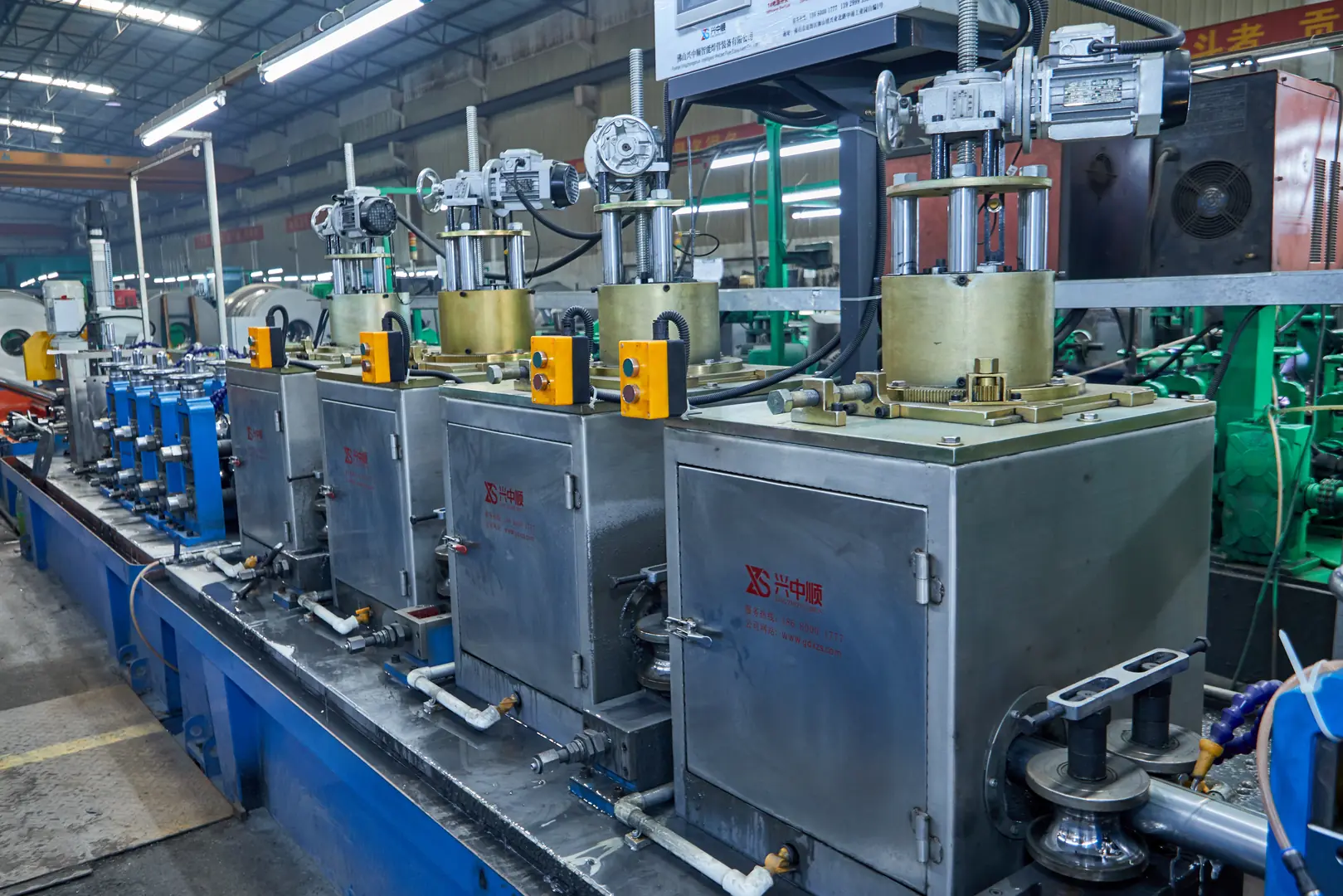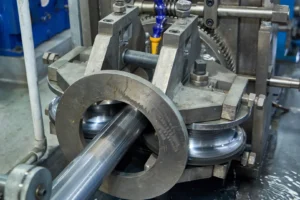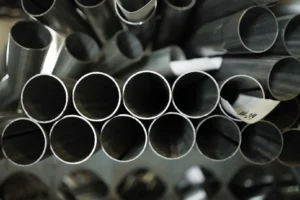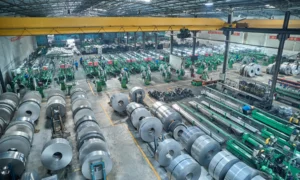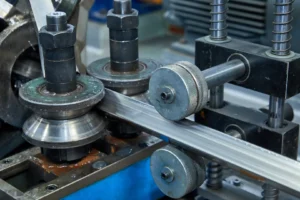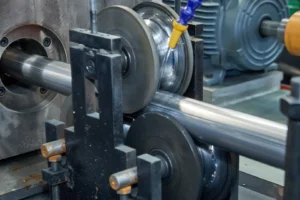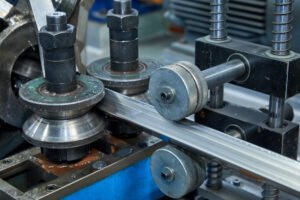Inside the Future Factory: How AI & IoT Elevate Tube Manufacturing Machinery Performance
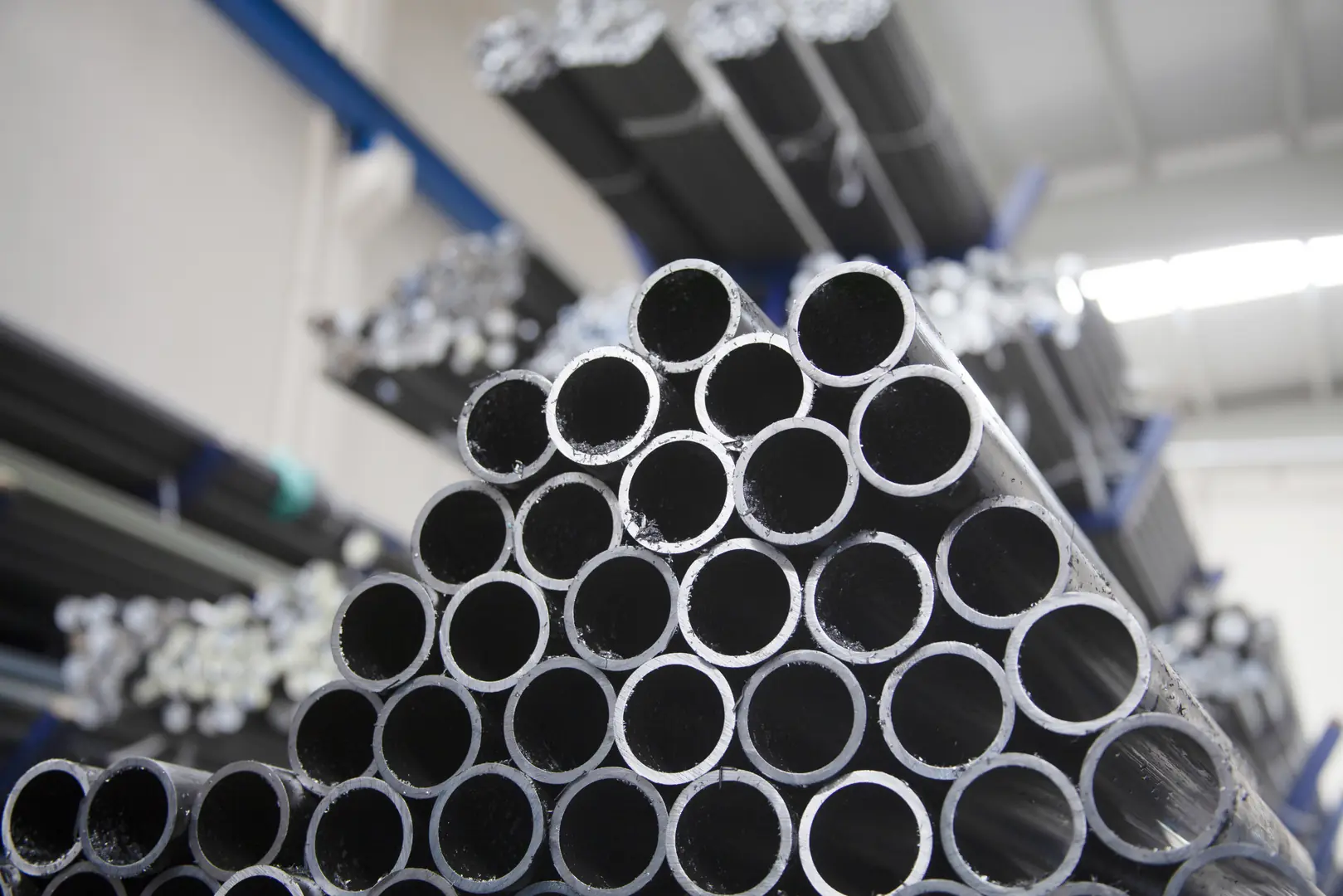
Are you facing relentless pressure to increase output and precision while simultaneously cutting operational costs? The limitations of traditional tube manufacturing machinery often lead to frustrating plateaus in efficiency, resulting in material waste, unexpected downtime, and a struggle to stay competitive in a demanding global market. The solution lies in embracing the next industrial revolution: integrating Artificial Intelligence (AI) and the Internet of Things (IoT) to transform your production floor into a smart, predictive, and highly efficient operation.
AI and IoT elevate tube manufacturing machinery performance by enabling predictive maintenance to slash downtime, utilizing real-time data for automated quality assurance, and continuously optimizing production parameters. This synergy boosts material utilization, increases throughput, and dramatically improves overall equipment effectiveness (OEE) for a smarter factory.
This transformation isn't just a futuristic concept; it's a tangible reality that we at XZS are helping our clients implement today. The journey to a smart factory is more accessible than you might think, moving beyond abstract buzzwords to deliver concrete ROI. It’s about empowering your existing workforce with intelligent tools to make better, faster decisions. Let’s explore how these technologies are practically applied to elevate your machinery’s performance and secure your competitive edge.
The term "smart factory" often evokes images of fully autonomous, lights-out manufacturing. While that is the ultimate horizon, the immediate value of AI and IoT lies in augmenting, not replacing, human expertise. From my 15 years in this industry, I've seen that the most successful implementations are not radical, overnight overhauls but strategic, incremental enhancements. It's about shifting from a reactive "fix it when it breaks" model to a proactive, data-driven culture of continuous improvement. This requires a dialectical approach—balancing the immense potential of technology with the practical realities of factory floors, investment cycles, and workforce skills. According to a study by McKinsey, manufacturers that integrate AI into their operations can see improvements in maintenance costs by up to 40% and reductions in downtime by up to 50%. This isn't just about bolting on new sensors; it's about re-architecting the flow of information from the machine right to your decision-makers, creating a powerful feedback loop that drives performance to new heights.
The Evolution of Tube Manufacturing: Integrating AI and IoT
Are your production schedules constantly disrupted by unexpected machine failures and quality inconsistencies? Relying on manual inspections and reactive maintenance is an outdated approach that directly impacts your profitability and reputation. The evolution towards a smart factory, powered by the integration of AI and IoT, provides a proactive, data-driven solution to these persistent manufacturing challenges, turning unpredictability into controlled efficiency.
The integration of AI and IoT represents a fundamental evolution in tube manufacturing, shifting the paradigm from manual, reactive operations to predictive, automated systems. This leap enables real-time machinery monitoring, data-informed decision-making, and self-optimizing production lines, revolutionizing operational efficiency and product quality control.
I remember visiting a client's plant years ago, where their most skilled operator could diagnose a potential roller issue simply by the sound and feel of the tube mill. He was a master of his craft, but his expertise was impossible to scale and would one day retire with him. This scenario perfectly illustrates the past of our industry. Today, the market demands a level of precision and consistency that even the most experienced hands cannot guarantee alone. That’s where the evolution into smart manufacturing becomes not just an advantage, but a necessity. A client of ours, a producer of high-grade sanitary-ware tubes in Brazil, was struggling with microscopic weld-seam imperfections that caused a high rejection rate. For them, integrating IoT sensors wasn't about replacing their expert team; it was about giving them supervision, empowering them with real-time data to catch deviations invisible to the human eye. This shift allows us to codify the "intuition" of a master operator into an algorithm, making that expertise scalable, repeatable, and operational 24/7. This transition doesn't diminish the role of people; it elevates them from manual laborers to strategic supervisors of an intelligent manufacturing ecosystem.
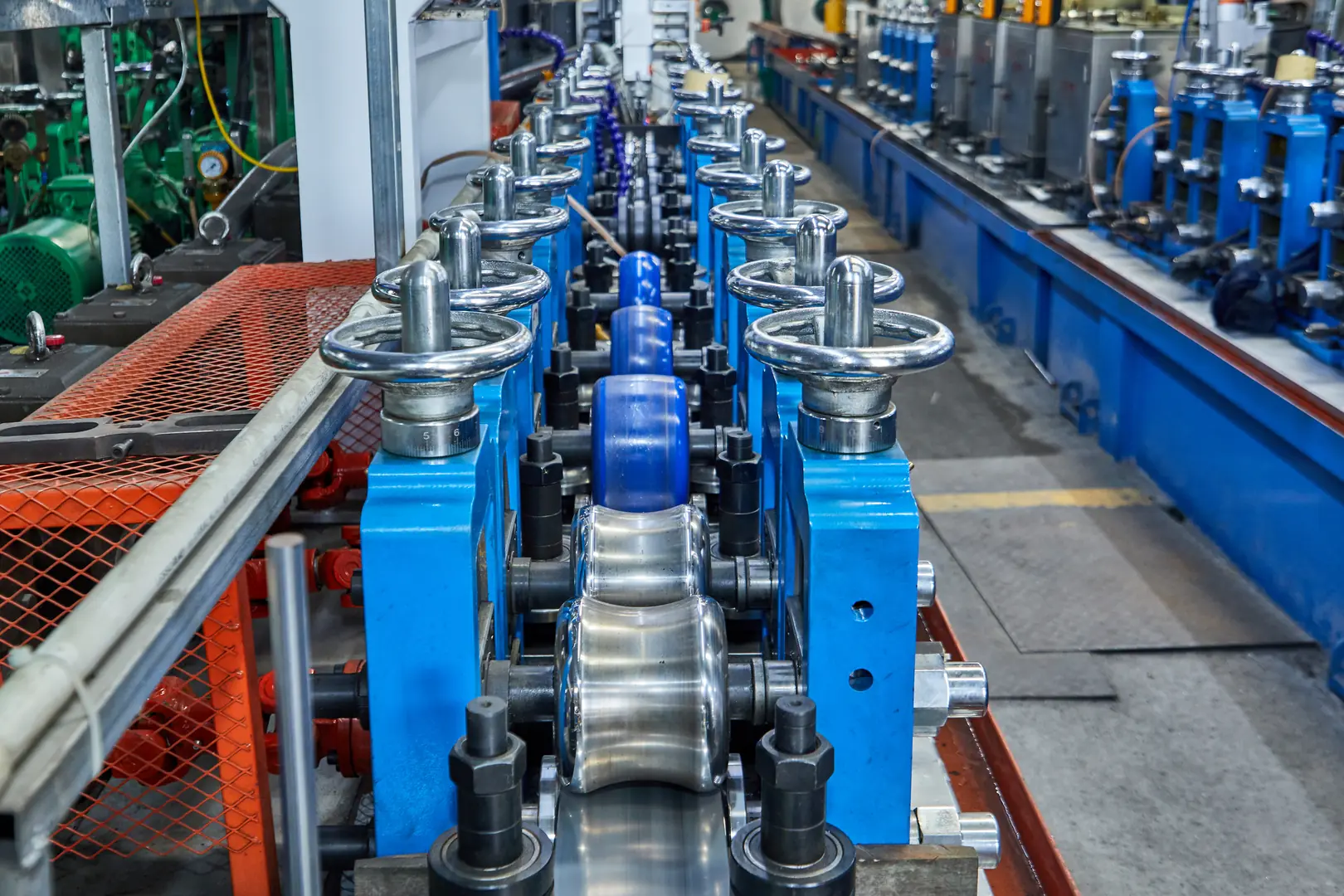
The journey from a basic mechanized tube mill to an intelligent, self-correcting production line is a story of gradual but profound transformation. It's a path we at XZS have not only witnessed but have actively engineered, guiding our clients through each technological leap. This evolution is driven by market forces demanding tighter tolerances, greater material efficiency, and customized production runs at mass-production speeds. The technology has finally caught up to the ambition, with the decreasing cost of sensors and exponential growth in computing power making the smart factory an attainable goal for manufacturers of all sizes, not just industry giants. This evolution unfolds across three key stages, each building upon the last to create a truly interconnected and intelligent system.
From Mechanization to Intelligence: A Paradigm Shift
The first tube mills were marvels of mechanization, replacing manual labor with powerful motors and gearboxes. The next great leap was automation, driven by Programmable Logic Controllers (PLCs), which allowed for pre-programmed sequences and a higher degree of control—a standard feature in all our XZS lines, such as the HF carbon steel pipe welding line. However, this was still a static form of control. The system followed orders but couldn't think or adapt. The current paradigm shift, the integration of AI and IoT, introduces the "thinking" layer. It’s the difference between a programmed robot and a truly intelligent system.
This isn't just a theoretical upgrade. The global industrial IoT market is projected to grow from hundreds of billions to over a trillion dollars in the coming years, a clear indicator of its widespread adoption and proven value. For a tube manufacturer, this shift means the machine no longer just executes a command; it provides feedback. It reports its health, monitors the quality of its own output, and flags subtle deviations before they become costly problems. It’s a move from a one-way command structure to a two-way conversation between the operator and the machine.
At XZS, we design our machines like the Intelligent precision stainless-steel welding-pipe production line with this evolution in mind. The robust PLC and touch-screen controls serve as the perfect foundation, a stable platform ready to be enhanced with IoT sensors and AI-driven analytics modules. This ensures that a client investing today has a machine that is not only top-of-the-line now but is also prepared for the innovations of tomorrow.
The Core Components of an AI/IoT-Enabled Tube Mill
To understand how this integration works, it's helpful to break down the core components. Think of it as giving the machine a nervous system, a network, and a brain. The first part is the sensory system. We strategically place a variety of sensors along the production line—vibration sensors on bearing housings, thermal imagers at the high-frequency welding point, optical scanners to inspect for surface scratches, and eddy current sensors to detect weld seam flaws. These are the "nerves," constantly gathering raw data on every aspect of the machine's operation and the tube's characteristics.
Next, this data needs to be transmitted and processed. This is the role of IoT connectivity, the "network." Using lightweight and efficient protocols, data from dozens of sensors is aggregated. Some initial processing might happen right at the machine level—what we call "edge computing"—to provide instant feedback for immediate adjustments. The bulk of the data, however, is securely sent to a central system, either on-premise or in the cloud, for deeper analysis. This is where the machine's "brain"—the AI and machine learning algorithms—comes into play.
These algorithms sift through millions of data points to identify patterns that a human could never detect. A machine learning model can learn the unique vibration signature of a healthy roller and flag the slightest deviation that signals impending failure. Another algorithm can analyze thermal images of the weld seam and correlate tiny temperature fluctuations with a higher risk of defects, allowing the system to adjust welding power in real-time. This is how we move from simply collecting data to generating actionable intelligence.
A Case Study in Proactive Production: The XZS Smart Line
Let's make this tangible with a real-world scenario. A valued client in Southeast Asia, a major supplier of stainless steel tubing for architectural projects, was facing a critical business challenge. They were experiencing a scrap rate of nearly 4%, primarily due to intermittent weld seam defects that were only discovered during post-production hydrostatic testing. This waste was eroding their margins and threatening a key contract. They were running one of our Reinforced heavy-duty welding-pipe machines, a powerful and reliable line, but they needed to elevate its intelligence.
We worked with them to deploy a customized AI/IoT upgrade. Our solution involved integrating a high-resolution thermal camera and an eddy current sensor right at the welding station. The data was fed into our proprietary AI monitoring module, which we trained using historical data of both "perfect" and "defective" pipe runs. The AI model learned the precise thermal and electromagnetic signature of a flawless weld on their specific product.
Within weeks of implementation, the system was flagging potential defects in real-time. For example, it would detect a minuscule 2% drop in weld temperature that was an early indicator of a potential flaw, automatically alerting the operator via the main control screen and suggesting a precise adjustment to the high-frequency welder's output. The results were transformative, as shown in the table below.
| Metric | Before AI/IoT Integration | After AI/IoT Integration | Improvement |
|---|---|---|---|
| Scrap Rate | 3.8% | 0.7% | 81.6% Reduction |
| Unplanned Downtime | 15 hours/month | 2 hours/month | 86.7% Reduction |
| Material Utilization | 94% | 98.5% | 4.8% Increase |
| Overall Equipment Effectiveness (OEE) | 75% | 89% | 18.7% Increase |
This case perfectly illustrates the evolution. The client's robust XZS machinery was the foundation, but by integrating AI and IoT, we transformed it from a powerful tool into an intelligent partner. They didn't just reduce waste; they gained a level of process control and predictability that unlocked new levels of profitability and solidified their reputation as a top-tier supplier.
Current Applications of AI and IoT in Tube Manufacturing Machinery
Are you wondering how AI and IoT translate from abstract concepts into concrete, value-adding applications on your factory floor? The fear is that these are complex, expensive technologies with unclear benefits. The reality is that targeted AI/IoT applications are already delivering massive ROI by tackling the most persistent problems in tube manufacturing: downtime, quality control, and inefficiency.
Current applications of AI and IoT in tube manufacturing focus on predictive maintenance to preempt failures, real-time quality assurance using machine vision, and dynamic process optimization. These tools analyze data from sensors to forecast wear, detect defects, and adjust settings automatically.
These applications are not science fiction; they are practical tools we are deploying with clients today. For instance, a producer of automotive exhaust components in the United States must adhere to incredibly strict quality and delivery schedules. For them, an unexpected shutdown of their tube mill isn't just an inconvenience; it's a critical failure that can halt their customer's entire assembly line. By implementing a predictive maintenance solution on their XZS industrial precision tube mill, we helped them shift from a reactive to a proactive stance. Vibration and temperature sensors on critical components, like gearboxes and roller bearings, feed data into a machine learning model. This model learned the unique operating signature of their machine and can now predict a potential bearing failure weeks in advance, allowing them to schedule maintenance during planned downtime. This single application converted costly, unpredictable stoppages into manageable, scheduled service events, saving them hundreds of thousands in potential losses and strengthening their relationship with their automotive clients. It’s about using data to replace uncertainty with predictability.

The practical application of AI and IoT in our industry has moved far beyond theoretical discussions and into the realm of tangible, bottom-line impact. These technologies are being deployed in targeted ways to solve the most costly and persistent challenges that tube producers face. At XZS, we focus on integrating these smart technologies not just for the sake of innovation, but to deliver measurable improvements in three critical areas: maximizing uptime through predictive maintenance, guaranteeing quality through intelligent assurance systems, and boosting efficiency through real-time process optimization. Each of these applications works by turning the vast stream of data from the production line into actionable intelligence that drives smarter, faster, and more profitable operations.
Maximizing Uptime with Predictive Maintenance
Unplanned downtime is the nemesis of any manufacturing operation. Every minute a tube mill is unexpectedly offline, money is lost in terms of lost production, idle labor, and potential penalties for late delivery. The traditional approach to maintenance is either reactive (fix it when it breaks) or based on a fixed schedule (replace parts every X months), both of which are highly inefficient. Reactive maintenance leads to catastrophic failures and extended stoppages, while scheduled maintenance often results in replacing parts that still have significant useful life remaining.
Predictive Maintenance (PdM), powered by AI and IoT, offers a far more intelligent solution. By embedding sensors that monitor key health indicators like vibration, temperature, and power consumption on critical machine components—such as the main drive motor, welding unit, and sizing rollers—we create a continuous health record. An AI algorithm analyzes this stream of data in real-time, learning the normal operating baseline. It can then detect minuscule deviations that are the earliest signs of degradation. For example, a subtle increase in the vibration frequency of a gearbox can indicate a developing gear tooth fault long before it becomes audible or causes a failure.
The system doesn't just raise an alarm; it provides a diagnosis and a prognosis. An alert on the operator's HMI might read: "Alert: Vibration pattern on Sizing Roller #3 indicates 85% probability of bearing failure within the next 150 operating hours. Recommend scheduling replacement during next planned shutdown." This allows the maintenance team to order the specific part and schedule the repair with surgical precision, eliminating unexpected downtime and maximizing the lifespan of every component. For an industrial equipment distributor integrating our lines, this feature becomes a powerful selling point, promising their customers unparalleled reliability.
Ensuring Perfection with AI-Powered Quality Assurance
Achieving 100% quality control is the ultimate goal. Manual, spot-check inspections are prone to human error and can only catch defects after a significant amount of scrap material has already been produced. AI-powered quality assurance automates and elevates this process to an unprecedented level of accuracy. On our Stainless steel precision tube mill lines, we can integrate high-resolution cameras and advanced sensors that act as tireless, incorruptible inspectors.
Machine vision systems, for example, can scan the entire surface of the moving tube, identifying cosmetic defects like scratches, stains, or discolorations that would be missed by the human eye. More critically, advanced technologies like eddy current testing systems, integrated with an AI module, can inspect the integrity of the weld seam from the inside out. The AI algorithm is trained on data from thousands of meters of pipe, learning to distinguish between a perfect weld and one with microscopic pinholes, cracks, or incomplete fusion.
When a potential defect is detected, the system can instantly trigger an alarm, spray a mark on the defective section for easy removal, and, most importantly, provide feedback to the control system. If the AI detects a pattern of minor defects emerging, it can correlate this with a specific machine parameter, such as a slight dip in welding temperature, and recommend an immediate, automatic adjustment. This creates a closed-loop quality system that doesn't just find defects but actively prevents them, pushing material utilization towards our 98% benchmark and ensuring that every meter of pipe meets the exact specification.
Driving Efficiency with Real-Time Process Optimization
Beyond keeping the machine running and the quality high, AI's most advanced application is in optimizing the entire production process for maximum efficiency. A tube mill is a complex system of interconnected variables: forming speed, roller pressure, welding power, cooling rate, and more. A minor adjustment in one area can have ripple effects throughout the line. Traditionally, finding the "sweet spot" for a new product or material has been a matter of operator experience and time-consuming trial and error.
AI transforms this art into a science. By analyzing historical production data, the AI model can build a comprehensive digital twin of the production line. This virtual model understands the complex relationships between all the variables. When a new job is entered—for example, a different tube diameter or wall thickness—the AI can instantly calculate the optimal starting parameters for speed, power, and pressure, dramatically reducing setup time and initial scrap.
Furthermore, it continues to optimize in real-time. If a sensor detects a slight increase in the hardness of the incoming steel coil, the AI can proactively adjust the roller pressure and forming speed to compensate, maintaining consistent tube dimensions without operator intervention. This dynamic optimization ensures the line is always running at its peak potential, maximizing throughput, minimizing energy consumption per meter, and achieving the kind of precision tolerance (≤ ±0.05 mm) that our clients in the automotive and sanitary-ware sectors demand. This is the heart of the future factory: a system that not only works but learns, adapts, and improves with every tube it produces.
Challenges Faced in Implementing AI and IoT Technologies
While the benefits are compelling, are you concerned about the practical hurdles of adopting AI and IoT? It’s wise to be cautious. The primary challenges clients face are the initial investment cost, anxieties about data security, and bridging the existing workforce's skills gap. These are significant but solvable obstacles that require a strategic, phased approach to technology adoption.
The primary challenges in implementing AI and IoT include the significant upfront capital investment for hardware and software, concerns over data privacy and cybersecurity threats, and the shortage of skilled personnel capable of managing and interpreting the complex data generated by these advanced systems.
Navigating these challenges is a core part of my role when consulting with clients. I often speak with business owners, from large-scale building-material wholesalers to specialized furniture-tube fabricators, and their concerns are valid and universal. The fear of a high initial cost can be paralyzing, especially when the ROI isn't immediately obvious on a spreadsheet. I had a client, a family-owned business producing decorative tubes, who saw our Tube polishing machine with an IoT monitoring package. They loved the potential but were hesitant about the price tag. Instead of pushing for a full-scale overhaul, we started by focusing on their single biggest pain point: inconsistent polishing quality that led to rework. We proposed a pilot project, a single sensor and analytics module focused exclusively on monitoring polishing pressure and consistency. The project was small, the cost was manageable, and the results were undeniable. Within three months, their rework rate dropped by 70%. This small win built the confidence and provided the clear ROI they needed to approve a broader, phased implementation across their facility. It proves that the journey to a smart factory doesn't have to be a giant, risky leap; it can be a series of small, confident steps.
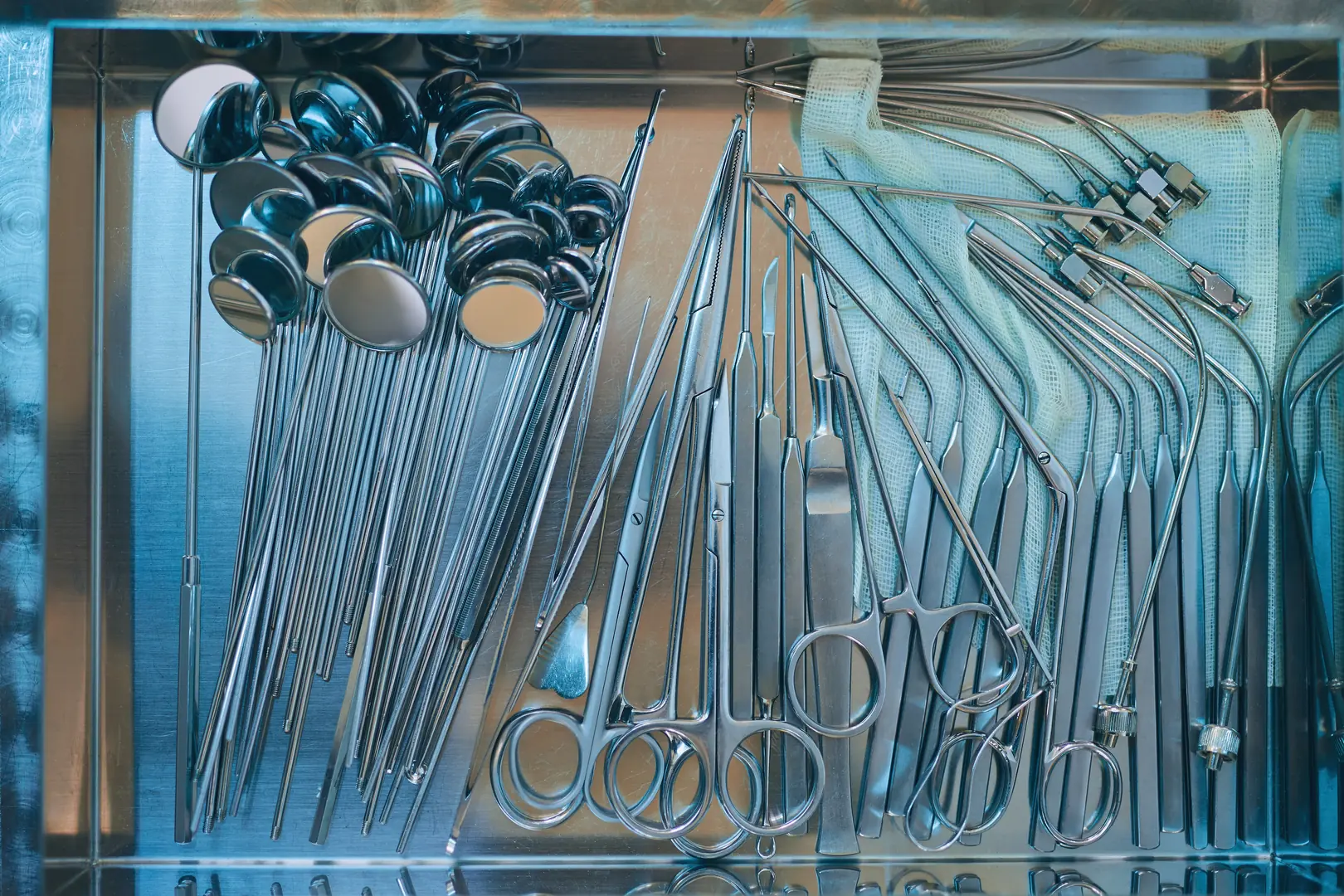
Adopting transformative technologies like AI and the Internet of Things is a strategic imperative, but it is not without its difficulties. Acknowledging and planning for these challenges is the first step toward a successful implementation. Over my years of guiding businesses through this transition, from large oil-and-gas pipeline contractors to nimble industrial equipment integrators, I've seen three primary hurdles emerge time and again: the financial barrier of initial investment, the technical and organizational hurdle of data management and security, and the human-centric challenge of the skills gap and cultural resistance. Overcoming these requires more than just technical solutions; it demands a strategic vision, careful planning, and a partnership approach between the technology provider and the manufacturer.
The Financial Hurdle: Initial Investment and ROI Justification
The most immediate and tangible barrier for many manufacturers is the upfront cost. Implementing an AI and IoT solution involves investment in new hardware (sensors, gateways, servers), software (analytics platforms, AI modules), and integration services. For many businesses, particularly small and medium-sized enterprises (SMEs), a significant capital expenditure requires rigorous justification and a clear, predictable return on investment (ROI). The challenge lies in the fact that many benefits of AI/IoT, such as improved brand reputation from higher quality or increased agility in production, are not as easy to quantify as a simple reduction in labor costs.
This financial pressure is real. A potential client in India, a producer of industrial tubes, was competing fiercely on price. They knew that reducing unplanned downtime on their Industrial precision tube mill would make them more competitive, but the cost of a full predictive maintenance suite seemed prohibitive. The key to overcoming this is to move away from an all-or-nothing mindset. Instead of quoting a massive, facility-wide overhaul, we work with clients to identify the single biggest "money pit" in their operation. Is it material waste from setup? Is it downtime on one specific, critical machine?
By targeting this one area with a focused pilot project, the initial investment is dramatically reduced, and the ROI becomes much faster and easier to measure. For the Indian client, we started with a vibration and thermal monitoring package on just the main gearbox of their most critical mill. The cost was a fraction of a full system, and within six months, it prevented two major failures, saving them more in downtime costs than the initial investment. This success created a powerful internal business case to fund the next phase of expansion.
The Technical Challenge: Data Management and Cybersecurity
Once the sensors are in place, they begin generating a massive volume of data. This presents a two-fold technical challenge: management and security. Firstly, how do you effectively collect, store, process, and analyze this data deluge? It requires a robust IT infrastructure, including network bandwidth, storage capacity, and powerful computing resources. Without a clear data strategy, companies risk creating a "data swamp," where valuable information is collected but never used effectively, or worse, is misinterpreted.
Secondly, and perhaps more critically, as you connect your operational technology (OT) like a tube mill to your information technology (IT) network, you introduce new cybersecurity vulnerabilities. A security breach could not only lead to the theft of sensitive production data but could potentially allow a malicious actor to disrupt or even damage physical machinery. For an oil-and-gas pipeline contractor, the integrity and security of their production data are paramount. The thought of their Large diameter tube mill's control system being exposed to the internet is a non-starter without ironclad security protocols.
Addressing this requires a security-first approach. At XZS, our integrated solutions are designed with multiple layers of security, including data encryption both in transit and at rest, secure authentication protocols, and network segmentation to isolate critical machine controls from external networks. We work with our clients' IT teams to ensure the solution complies with their corporate security policies and best practices, providing them with the confidence that their data and operations are protected.
The Human Element: Skills Gap and Organizational Resistance
Technology is only as effective as the people who use it. The third major challenge is the human element. The skills required to manage and operate an AI-driven production line are different from those needed in a traditional factory. It requires a workforce that is comfortable with data analysis, software interfaces, and collaborating with intelligent systems. This often reveals a skills gap within the existing team. Operators who were once valued for their mechanical intuition must now learn to trust and interpret data from a dashboard.
Furthermore, there can be cultural resistance to change. Employees may fear that AI and automation are there to replace them, leading to pushback and a reluctance to embrace new workflows. It is crucial to frame the adoption of AI not as a replacement for human workers, but as an augmentation of their skills. We are giving them powerful new tools that eliminate tedious, repetitive tasks and allow them to focus on more valuable, strategic activities.
We tackle this challenge head-on through comprehensive training and support. When we commission a new intelligent line, our service includes extensive training for both operators and maintenance staff. We teach them how to read the analytics dashboards, how to respond to AI-generated alerts, and how the system makes their jobs easier and more effective. For one client, a furniture fabricator, we helped them create a new role: "Line Analyst." This was an experienced operator who we trained to be the go-between for the AI system and the rest of the floor team, championing the new technology and translating its insights into practical actions. This approach fosters buy-in and transforms fear into enthusiasm.
Strategies to Overcome Barriers in AI and IoT Adoption
Are the challenges of implementation making you hesitant to move forward? Don't let the hurdles halt your progress. With a clear and pragmatic strategy, you can successfully navigate the barriers of cost, complexity, and culture. The key is to start small, prioritize based on impact, and focus on empowering your team through a phased and collaborative approach.
Effective strategies to overcome adoption barriers include initiating pilot projects to demonstrate value, choosing modular and scalable solutions for phased implementation, investing in comprehensive workforce training, and partnering with experienced technology providers like XZS who offer turnkey support and guidance.
This strategic approach is fundamental to how we ensure our clients succeed. A building-material wholesaler in Europe wanted to upgrade their capabilities by installing a new HF carbon steel pipe welding line. They were new to this level of automation and were concerned about the learning curve and the risk of a complex, monolithic installation. We didn't present them with a single, massive project. Instead, we co-developed a multi-phase roadmap. Phase one focused on the core, high-performance welding line with its standard PLC controls to get their team comfortable and productive. Phase two, planned for six months later, involved adding an IoT predictive maintenance package for the critical components. Phase three will introduce an AI-powered quality control module. This modular, "start smart, then scale" strategy breaks down a daunting transformation into manageable, value-driven steps. It de-risks the investment, allows the team to grow alongside the technology, and ensures that each new feature is built upon a solid foundation of operational success. This turns a giant leap into a confident climb.
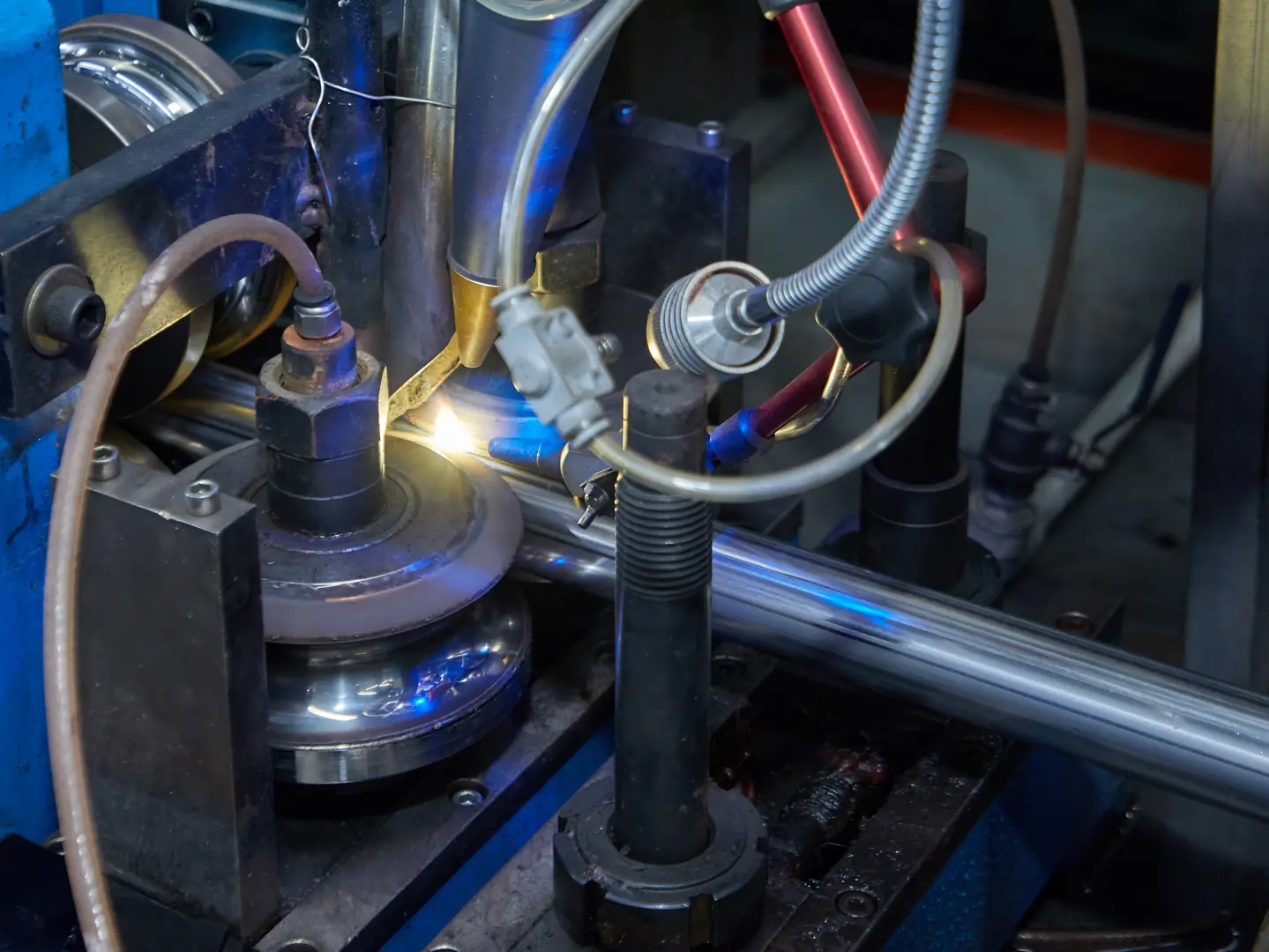
Successfully integrating AI and IoT into a tube manufacturing environment is not about having the biggest budget or the most advanced technology; it's about having the right strategy. The path to the smart factory is paved with practical decisions, incremental progress, and a deep understanding of both the technology's potential and the organization's capacity for change. At XZS, we act as more than just an equipment supplier; we serve as a strategic partner, guiding our clients through a proven framework for adoption that mitigates risk, maximizes ROI, and builds a sustainable culture of innovation. This framework is built on three pillars: a strategic, phased implementation model; a focus on upskilling the workforce; and fostering a strong partnership ecosystem.
Phased Implementation: The "Start Smart, Scale Fast" Model
The single most effective strategy to overcome the primary barriers of cost and complexity is to reject the "big bang" approach in favor of a phased, modular implementation. Instead of attempting to transform the entire factory at once, we identify the area of greatest pain or highest potential return and begin there with a focused pilot project. This "start smart" approach has numerous advantages. It dramatically lowers the initial financial barrier, making the project accessible even to smaller operations. It contains the risk to a single line or process, allowing for learning and adjustment in a controlled environment.
A perfect example is a client who produces components for heat exchangers. Their main issue was material waste during the setup of new production runs on their Stainless steel precision tube mill line. We proposed a pilot project focused solely on an AI-powered process optimization module for setup. The module, using machine learning, analyzed past successful setups to recommend optimal initial settings for any new job, drastically reducing the trial-and-error period. The project was implemented in under two months. Its success—a 60% reduction in setup scrap—provided a concrete, quantifiable ROI.
This initial win creates momentum and a powerful business case for the next phase, embodying the "scale fast" principle. With the value proven, the client gained the confidence and budget approval to scale the solution, first to other similar lines and then by adding new modules for predictive maintenance and quality control. This iterative model turns a daunting capital project into a series of manageable, self-funding operational improvements.
Empowering the Workforce: Investing in People and Skills
Technology alone does not create value; people do. A critical, and often overlooked, strategy is to invest in upskilling and empowering the workforce concurrently with the technology rollout. Resistance to change often stems from fear of the unknown or fear of becoming obsolete. The best way to counter this is with education, involvement, and a clear vision of how the new technology makes employees more valuable, not less.
Our strategy begins during the project's planning phase. We insist on involving the operators, maintenance technicians, and floor supervisors who will be using the system daily. Their practical insights are invaluable for designing user-friendly interfaces and ensuring the AI's outputs are practical and actionable. Before commissioning an intelligent XZS line, we provide comprehensive, role-specific training. Operators learn to interpret the data dashboards, maintenance crews learn to act on predictive alerts, and managers learn how to use the analytics to make better strategic decisions.
We also help clients redefine roles to align with the new technology. The most experienced operator on the floor might be retrained as a "System Analyst," responsible for monitoring the AI's recommendations and providing feedback to improve the algorithms. This not only leverages their deep domain knowledge but also creates a career path and demonstrates a commitment to the existing workforce. By turning employees into champions of the new system, we transform the challenge of a skills gap into an opportunity for professional growth and increased engagement.
Fostering Collaboration: The Power of Strategic Partnerships
No company can be an expert in everything. A successful AI/IoT implementation requires a blend of expertise: deep knowledge of tube manufacturing machinery, sophisticated software and AI capabilities, and robust IT and data security skills. The most successful adoption strategies are built on a foundation of strong, collaborative partnerships. As a manufacturer of tube mills, our core expertise is in the physical process of forming and welding tubes with extreme precision. We provide the robust, reliable, and "smart-ready" mechanical platform.
To deliver the best-in-class AI and IoT solutions, we partner with leading technology firms specializing in industrial analytics, machine learning, and cybersecurity. This ecosystem approach allows us to offer our clients a truly turnkey solution that is greater than the sum of its parts. Our clients get the benefit of our 15+ years of manufacturing expertise combined with cutting-edge digital technology, all integrated into a single, seamless package.
This partnership extends to the client themselves. We view every implementation as a joint venture. We work closely with their operations and IT teams to ensure our solution integrates perfectly with their existing infrastructure and workflows. We establish clear communication channels and feedback loops to continuously refine and improve the system post-installation. This collaborative model de-risks the project for the client, as they are not left to manage multiple vendors or navigate complex integration challenges alone. It ensures they have a single point of accountability and a dedicated partner committed to their long-term success.
Technical Recommendations for Enhancing Machinery Performance
Once you've decided to embrace AI and IoT, what are the specific technical steps to take? To truly enhance machinery performance, you must build on a solid foundation. This means starting with robust, automation-ready equipment, implementing a scalable data architecture, and selecting AI models that are tailored to solve specific, high-value manufacturing problems.
Key technical recommendations include selecting modular, automation-ready machinery with open communication protocols, implementing a hybrid edge/cloud data infrastructure for real-time and deep analytics, and deploying specialized AI models for predictive maintenance, quality vision systems, and process optimization.
These recommendations are the blueprint we use at XZS. When an automotive exhaust manufacturer approached us to build a new production line, their primary demand was future-proofing. They needed high performance today and the ability to easily integrate smarter technologies tomorrow. Our recommendation started with our Heavy-duty tube mill, chosen for its robust, CNC-machined frame that ensures long-term stability—a prerequisite for collecting clean sensor data. The machine's standard fully automated PLC + touch-screen control system was the crucial second element. This system acts as a central hub, ready to communicate with any new sensors or AI modules we add. We recommended a phased approach: start with the base machine, then add an edge computing device to monitor welding parameters in real-time, and later connect this to a cloud platform for predictive analytics across their entire fleet. This layered, technically sound approach ensures scalability and performance.
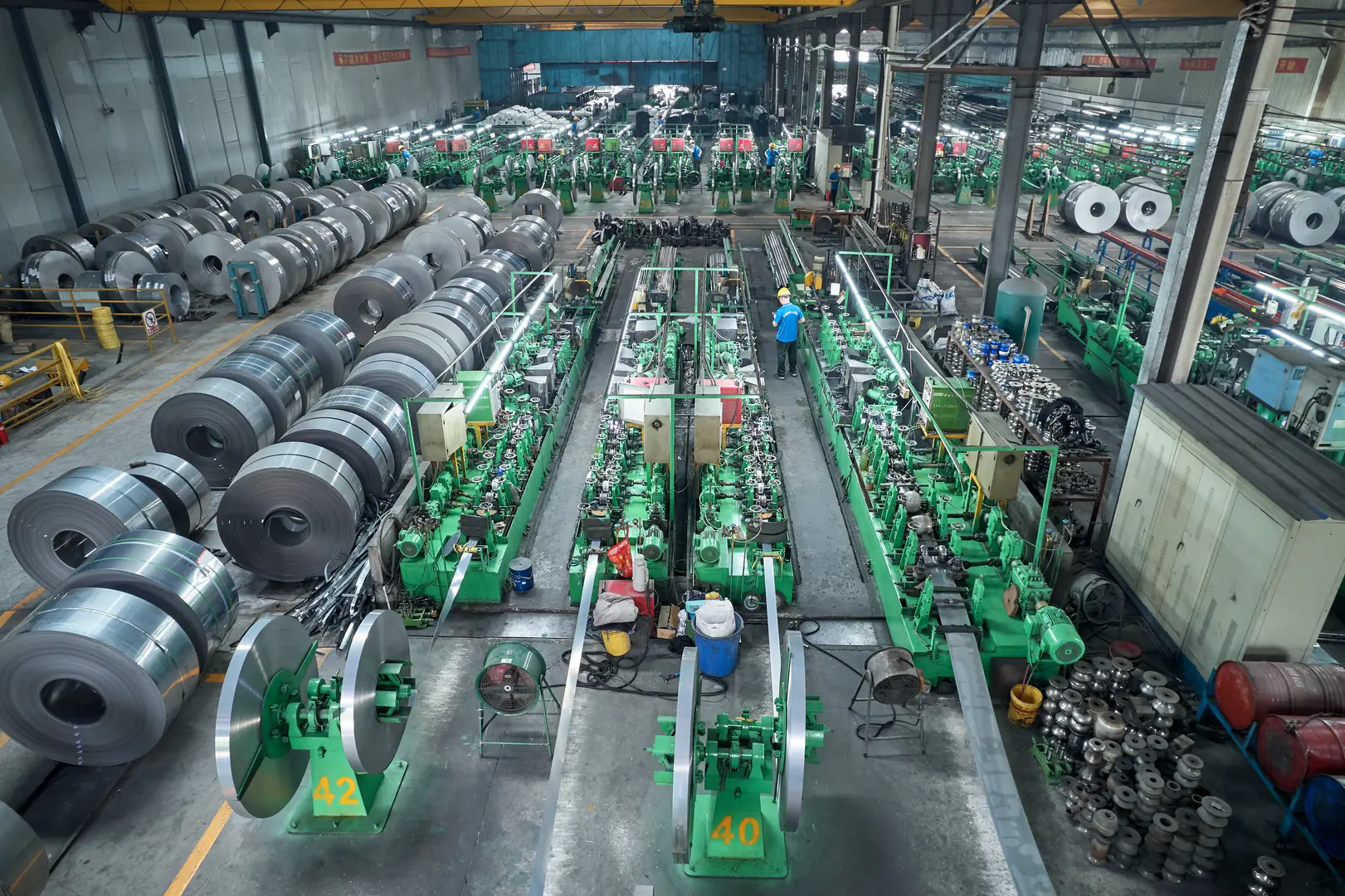
To transition from strategy to execution, a set of clear technical recommendations is essential. Enhancing machinery performance with AI and IoT is an engineering challenge that requires a solid architectural foundation. Simply scattering sensors across a machine will only create noise; a deliberate, structured approach is needed to generate meaningful intelligence. As an ISO 9001-certified manufacturer, we build our machines and solutions on principles of precision, reliability, and forward-compatibility. Our technical recommendations reflect this philosophy, focusing on creating an integrated system where the hardware, data infrastructure, and AI algorithms work in concert to deliver peak performance. The goal is to build a system that is not only powerful but also scalable, secure, and manageable for the long term.
Foundation First: Selecting Automation-Ready Machinery
The quality of your data is limited by the quality of your machine. Before a single sensor is installed, the foundation must be a robust, stable, and precisely controlled tube mill. A machine frame that vibrates excessively or has inconsistent mechanical performance will generate noisy, unreliable data, making any AI analysis meaningless. This is why our XZS lines, from the Large diameter tube mill to the Industrial precision tube mill, are built on heavy-duty, CNC-machined frames that provide exceptional rigidity and long-term durability. This mechanical stability is the bedrock of high-fidelity data collection.
Equally important is the machine's native control system. The technical recommendation is to choose machinery equipped with a modern, open-architecture PLC and HMI system. Our standard fully automated PLC + touch-screen control is not a closed black box; it's designed to be the central nervous system of the line, capable of easily communicating with third-party devices and software. It should support standard industrial communication protocols (like OPC-UA or MQTT), which simplifies the process of extracting operational data and sending commands back to the machine. Investing in a machine that is "automation-ready" from day one dramatically reduces the complexity and cost of future AI/IoT integrations.
ly, consider modularity in the machine design itself. Features like our quick-change tooling systems are not just for operational flexibility; they also simplify the integration of new technology. When tooling cassettes can be easily swapped, it becomes easier to embed sensors or inspection devices directly where they are needed most. A well-designed machine is the launchpad for any successful smart factory initiative.
Architecting the Data Flow: A Hybrid Edge-Cloud Approach
With a solid machine in place, the next technical step is to design the data architecture. A "one-size-fits-all" approach, like sending all data directly to the cloud, is inefficient and often impractical. The best-practice recommendation is a hybrid architecture that intelligently combines edge computing and cloud computing.
Edge computing is performed by a small, powerful industrial computer located right next to the production line. Its job is to process data that requires an immediate, real-time response. For example, data from a machine vision camera inspecting for weld defects needs to be analyzed in milliseconds to trigger a rejection mechanism. Sending this data to a distant cloud server would introduce too much latency. The edge device can run a streamlined AI model to make these instant decisions, ensuring real-time process control and quality assurance.
The cloud, on the other hand, is used for tasks that require massive computational power and historical data storage. The edge device can send summarized data or specific alerts to the cloud for deeper analysis. Here, more complex AI models can analyze trends over weeks or months from multiple machines to perform predictive maintenance analytics, identify slow-moving efficiency drifts, and provide management-level dashboards. This hybrid model provides the best of both worlds: the immediate responsiveness of the edge and the powerful, long-term analytical capabilities of the cloud, all while optimizing network bandwidth.
Deploying Purpose-Built AI Models
Artificial Intelligence is not a single technology; it's a toolbox of different techniques. The final technical recommendation is to select and deploy AI models that are purpose-built for the specific problem you are trying to solve. Using a generic data analytics platform is often less effective than using specialized algorithms trained on manufacturing-specific data.
For predictive maintenance, the most effective models are often "unsupervised learning" algorithms that can learn the normal operating signature of a machine and flag anomalies. For quality control via machine vision, "supervised learning" models, specifically Convolutional Neural Networks (CNNs), are the industry standard. These models are trained on thousands of labeled images of "good" and "bad" products to become incredibly accurate at spotting defects.
For process optimization, we often use "reinforcement learning" models or create a "digital twin" of the production line. This virtual model can run thousands of simulations in a fraction of a second to determine the optimal machine settings for a given set of inputs (e.g., material type, ambient temperature, desired output). At XZS, our R&D, supported by advanced simulation labs, focuses on developing and refining these specific AI applications. We provide our clients not just with the machinery, but with a suite of proven, purpose-built AI models that are pre-trained and ready to deliver value, accelerating their journey to enhanced performance and efficiency.
Conclusion
Ultimately, integrating AI and IoT is the definitive step toward a future-proof manufacturing operation. This evolution moves beyond simple automation to create intelligent, self-aware production lines that maximize uptime, perfect quality, and optimize efficiency, securing a decisive competitive advantage in the global marketplace.
